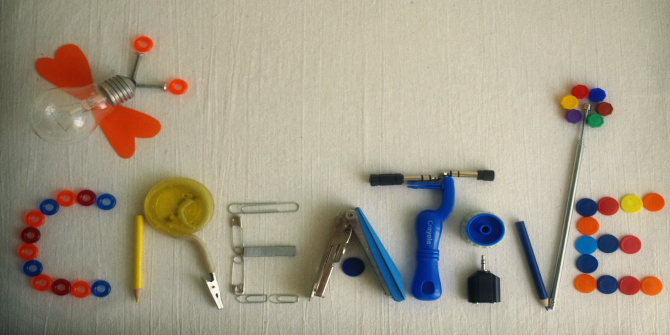What creative methods of research communication can help scholars get their message ‘out there’ effectively? In Creative Research Communication: Theory and Practice, Clare Wilkinson and Emma Weitkamp offer a new guide accessible to researchers working across the arts, humanities, social and natural sciences. Wilkinson and Weitkamp successfully blend the theoretical and the practical in an approachable manner in an excellent book full of interesting and relevant content for academics and non-academics alike, writes Paul Webb.
Creative Research Communication: Theory and Practice. Clare Wilkinson and Emma Weitkamp. Manchester University Press. 2016.
Find this book (affiliate link): ![]()
 The philosopher A.C. Grayling has characterised academics as specialists in a small area of intellectual endeavour who publish their research in journals for other specialists in a language that is often inaccessible to the uninitiated (2004, 100). One could be more charitable and concede that academics do try to communicate beyond the circle of their academic peers, but that communication outside of academia can be difficult and perplexing due to the sheer number of options available. So where should the researcher who wants to get their message ‘out there’ begin? Clare Wilkinson and Emma Weitkamp’s book, Creative Research Communication: Theory and Practice, could be one possible starting point.
The philosopher A.C. Grayling has characterised academics as specialists in a small area of intellectual endeavour who publish their research in journals for other specialists in a language that is often inaccessible to the uninitiated (2004, 100). One could be more charitable and concede that academics do try to communicate beyond the circle of their academic peers, but that communication outside of academia can be difficult and perplexing due to the sheer number of options available. So where should the researcher who wants to get their message ‘out there’ begin? Clare Wilkinson and Emma Weitkamp’s book, Creative Research Communication: Theory and Practice, could be one possible starting point.
The authors contend that this book has been written for ‘public engagement practitioners, policymakers, science communication students and those based in research settings who are seeking to communicate to and engage others with their research’ (14). This is an assessment with which I agree, as Wilkinson and Weitkamp have written a text that is extremely easy to read and therefore accessible to both non-academics and academics across the arts, humanities, social and natural sciences. The authors almost always eschew jargon, adding to the appeal of the book, and the sections on theory usefully complement rather than crowd out the practical advice that they offer to the reader. Wilkinson and Weitkamp also make a persuasive case for the view that it is possible to present research to a lay audience which does not distort the complexity and nuance of scholarly endeavour.
The authors’ key message is therefore an optimistic one: academics can maintain high standards whilst at the same time recognising the diverse needs of an often very plural audience. The use of the word ‘creative’ in the book’s title should also reassure those readers who may be under the impression that research communication involves the use of an invariable and universally applicable set of procedures. On the contrary, Wilkinson and Weitkamps’ reservations about metrics, together with their injunction that readers should ‘engage in ways that work for you as an individual researcher’ (10), will no doubt be reassuring to all.
The book is divided into three parts. The first section introduces the reader to ‘the context of research communication’ (15). What then follows is a fascinating if concise description of the role of research communication over a four-hundred-year period, which describes the process of research professionalisation, the creation of learned societies, public lectures and the role of museums and exhibitions. Brief references are made to such august institutions as the Royal Society, the Royal Institution, the Lunar Society and Mechanics’ Institutes. I particularly enjoyed the historical tour and would have appreciated more detail, although I recognise that the authors are trying to chart a middle way between the theoretical and the practical.
The first part of the book ends with advice on how to include people in research as either participants or the audience of research. Again, the inclusion of this information is laudable as the authors stress that ‘the public’ should not be thought of as one homogenous group, but rather that ‘participants in research communication come from a variety of backgrounds, communities, experiences and perspectives’ so that ‘the idea of one exclusive and singular public is therefore problematic’ (34). Praiseworthy too is their recognition that the ‘deficit model’ – ‘whereby […] the perceived deficiencies in people’s knowledge around complex research areas created drivers for the receipt of increased information’ – is no longer adequate (39).
Lest all this seems excessively theoretical, the second part provides solid practical advice on face-to-face communication, artist-researcher collaborations, digital research communication, the use of social media and citizen-science projects as well as research which has been initiated by the community. Indeed, the authors manage to reference projects that illustrate their advice that are not only multi-disciplinary but trans-disciplinary. In short, there is sure to be something here which will wet the reader’s appetite. In particular, I thought that their advice on how to ‘pitch’ and write articles for newspapers and magazines was especially useful, although some detail on how to work with the traditional broadcast media would have been welcome too.
The authors also make information easy to find by availing of boxed-out sections that are interspersed throughout the text, whilst further grounding their advice by referring to real world case studies. Box 7.4, for example, provides ‘Top tips for academic bloggers’ (145), and case study 7.2 describes Science Circle – ‘a space to talk about research and education in the virtual world Second Life’ (156). Useful references for further reading are also included at the end of each chapter and in a dedicated reference section, together with a plethora of relevant internet links.
Although obviously passionate about their subject, the authors are not dewy-eyed about the communication approaches which they discuss but, on the contrary, deal with a range of problems that may arise. Providing a space in which people can engage with research can have many benefits as the authors attest, including improving research quality, increasing public trust and awareness in research as well as making people more predisposed to being involved in future projects (174). However, engagement can be frustrating for those researchers who may not feel that they are setting agendas – particularly in highly specialised areas of research where it may be difficult for the public to understand the nature of a researcher’s work. Conversely, the public may feel that engagement could be more accurately characterised as a one-directional information and communication exercise as opposed to an authentic two-directional partnership between different stakeholders, all of whom have some intellectual and emotional investment in the research project (173-75). Engagement therefore presents challenges for the researcher. The authors recognise this, and their pragmatism can only add credibility to the text.
The third and final part examines impact, ethics and dissemination. Wilkinson and Weitkamp introduce the reader to formative, process and summative evaluation, basic research methods, analytical techniques and free analysis programmes. Box 10.3 also includes invaluable information on evaluation frameworks (222). Their discussion then concludes with an examination of research impact, which will be of special interest to academics, although the authors convincingly problematise this concept rather than offer easy solutions. One only has to think of how difficult it would be to measure the existential, ‘transformative’ impact of the arts on the individual to appreciate that they have a point (228). This discussion will undoubtedly appeal to academics, service evaluators, policymakers and any reader of research. A similar comment applies to the chapter on ethics with its fascinating aside on the difficulties of informed consent in situations where the medium- to long-term impact of some research may be unknowable (238-39), whilst the final discussion on dissemination is equally engaging, with Box 12.4 providing a useful list of academic journals for research communicators (263).
Wilkinson and Weitkamp have managed to write a book that successfully blends the theoretical with the practical. They never talk down to the reader, and it is for this stylistic reason, as well as for the interesting, relevant content, that Creative Research Communication should be read by anyone with an interest in research. This is an excellent book that can be read from cover to cover or used as a reference text.
Note: This review gives the views of the author, and not the position of the LSE Review of Books blog, or of the London School of Economics. The LSE RB blog may receive a small commission if you choose to make a purchase through the above Amazon affiliate link. This is entirely independent of the coverage of the book on LSE Review of Books.
Image Credit: (bee) creative (Asja Boroš CC BY 2.0).









2 Comments